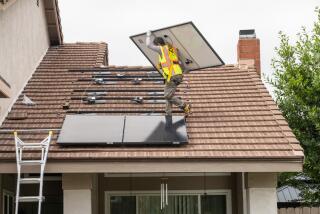Germany takes a shine to solar
- Share via
BONN, GERMANY — It rains year round in Germany. Clouds cover the skies for about two-thirds of all daylight hours. Yet the country has managed to become the world’s leading solar power generator.
Even though millions of Germans flee their damp, dark homeland for holidays in the Mediterranean sun, 55% of the world’s photovoltaic power is generated on solar panels set up between the Baltic Sea and the Black Forest.
So far just 3% of Germany’s electricity comes from the sun. But the government wants to increase the share from the sun and other renewable energy sources from today’s 13% to 27% by 2020.
It is a thriving industry with booming exports that has created tens of thousands of jobs in recent years, posting growth rates that surpassed the optimistic forecasts made by the fathers of a pioneering 2000 renewable energy law.
This law, known by the initials EEG, has helped this country become a solar giant.
“The EEG was the single-most-important vehicle to boost the solar energy market,” said Frank Asbeck, chairman of SolarWorld. The law, which offers cash incentives to people introducing renewable energy sources, was designed to help fight climate change and reduce dependency on fossil fuels.
“There has also been an enormous interest for solar power from the public in general,” added Asbeck, who in 1988 started his Bonn-based company making and marketing photovoltaic products. Its payroll has doubled in the last two years to 1,350.
“Germans have a fondness for inventing and developing technologies. Helping fight climate change is a bonus,” said Asbeck, who plans to nearly double the number of employees again within two years.
There are now more than 300,000 photovoltaic systems in Germany -- the energy law had planned for 100,000.
Spread out across the country, they are owned by legions of homeowners, farmers and small businesses who are capitalizing on the government-backed march into renewable energy.
By tapping the daylight for electricity -- which power companies are obliged to buy for 20 years at more than triple market prices -- they are at the vanguard of the fight against global warming.
“It’s grown much faster than anyone thought it would,” said Juergen Trittin, the former environment minister who masterminded the scheme. He was mocked at the time for his claims it would create jobs and not hurt the economy.
There are now 250,000 jobs in Germany in the renewable energy sector. Asbeck expects the number of jobs in solar power alone to double to 90,000 over the next five years and hit 200,000 in 2020.
The law has also since served as a model for other European countries including Spain, Portugal, Greece, France and Italy.
Germany’s photovoltaic systems generate about 3,000 megawatts of power -- 1,000 times more than in 1990.
Asbeck said political decisions in the 1990s made it easy and even lucrative for ordinary people to put the systems on their roofs.
At the heart of the scheme is a “feed-in tariff” giving anyone who generates power from solar, wind or hydro a guaranteed payment from the local power company. The power firms are obliged to buy solar electricity for 49 cents per kilowatt hour -- or nearly four times market rates.
This can work out at a better return than putting money in the bank. So despite the cloudy weather, the investment pays for itself within 10 years.
There are some critics of the solar power incentives who want the government to phase out the program faster than now planned. The lucrative payments for solar power are, however, guaranteed for 20 years for all existing owners.
Gerhard Mueller-Westermeyer, a climate researcher at the German national weather service, said most of Germany is covered by clouds between 62.5% and 75% of the time and there are only a handful of days each year with no clouds at all.
“Obviously, there would be a better return on solar panels set up in sunnier places like Africa,” he said. “But the energy would have to be transported and that’s difficult. So it makes sense to build solar panels where people need them.”
More to Read
Sign up for Essential California
The most important California stories and recommendations in your inbox every morning.
You may occasionally receive promotional content from the Los Angeles Times.












